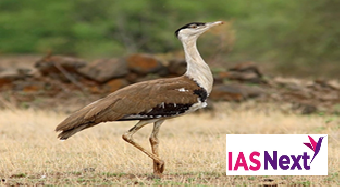CURRENT AFFAIRS
Get the most updated and recent current affair content on Padhaikaro.com
Great Indian Bustard (GIB)
- IAS NEXT, Lucknow
- 15, Dec 2021

Reference news-
Recently, the Centre has approached the Supreme Court seeking modification of its order directing that all transmission cables in the habitat of the Great Indian Bustard (GIB) be laid underground.
- Background:
- Earlier this year (2021), in a bid to check the dwindling numbers of the endangered Great Indian Bustard and Lesser Florican, a Supreme Court bench directed that overhead power lines be laid underground, wherever feasible, passing along the habitat of the birds in Rajasthan and Gujarat.
- Concerns Raised:
Implications for the Power Sector in India:
The area falling in Rajasthan and Gujarat contains a large proportion of the country’s total solar and wind energy potential.- Laying power lines underground will escalate the cost of renewable energy production and hurt India’s renewable energy cause.
Energy transition is essential for reducing emission and controlling climate change and India has made international commitments including under the agreement signed in Paris in 2015 under the United Nations Framework Convention on Climate Change (UNFCCC) for transition to non-fossil fuels and for emission reduction.
- India has set a target to achieve installed renewable energy capacity (excluding large Hydro) of 175 GW by 2022 and 450 GW by 2030.
- Laying power lines underground will escalate the cost of renewable energy production and hurt India’s renewable energy cause.
- Concerns Raised:
- Chances of Renewable Energy to Remain Untapped:
- So far, only a miniscule 3% of the estimated potential of around 263 GW renewable energy in this area has been tapped.
- If the remaining potential stays untapped, an additional 93,000 MW of coal fired capacity will be needed to replace the unutilised renewable energy in the future which would cause an adverse direct impact on the environment.
- Earlier this year (2021), in a bid to check the dwindling numbers of the endangered Great Indian Bustard and Lesser Florican, a Supreme Court bench directed that overhead power lines be laid underground, wherever feasible, passing along the habitat of the birds in Rajasthan and Gujarat.
- About:
- It is the State bird of Rajasthan and is considered India’s most critically endangered bird.
- It is considered the flagship grassland species, representing the health of the grassland ecology.
- Its population is confined mostly to Rajasthan and Gujarat. Small populations occur in Maharashtra, Karnataka and Andhra Pradesh.
- The bird is under constant threats due to collision/electrocution with power transmission lines, hunting (still prevalent in Pakistan), habitat loss and alteration as a result of widespread agricultural expansion, etc.